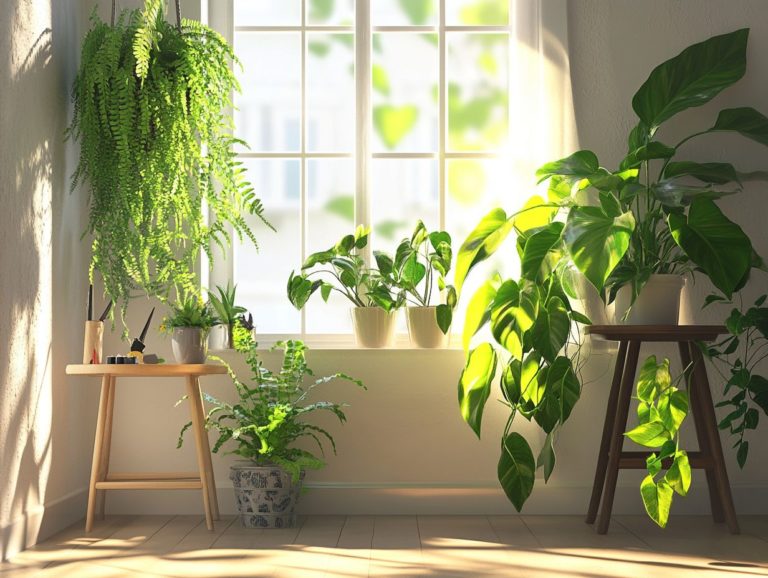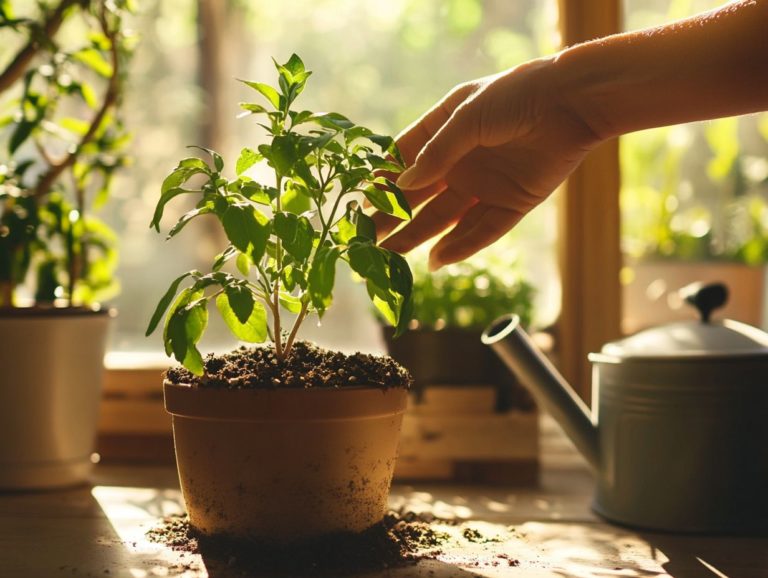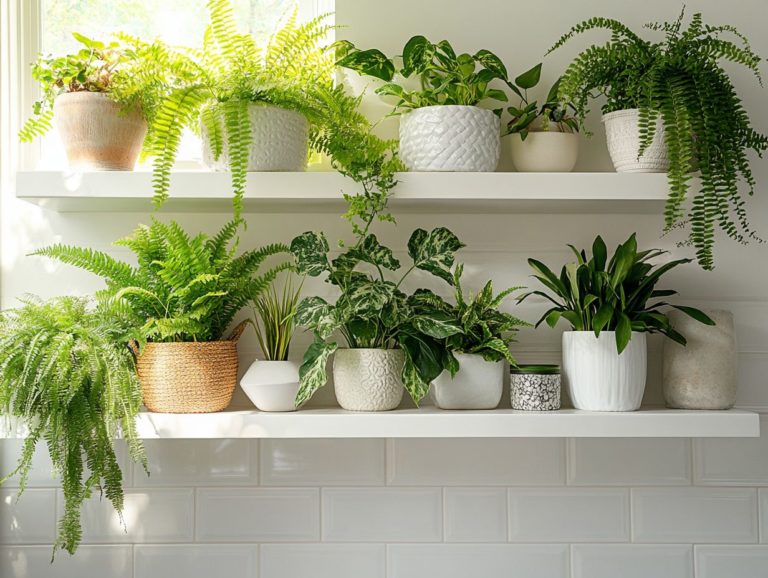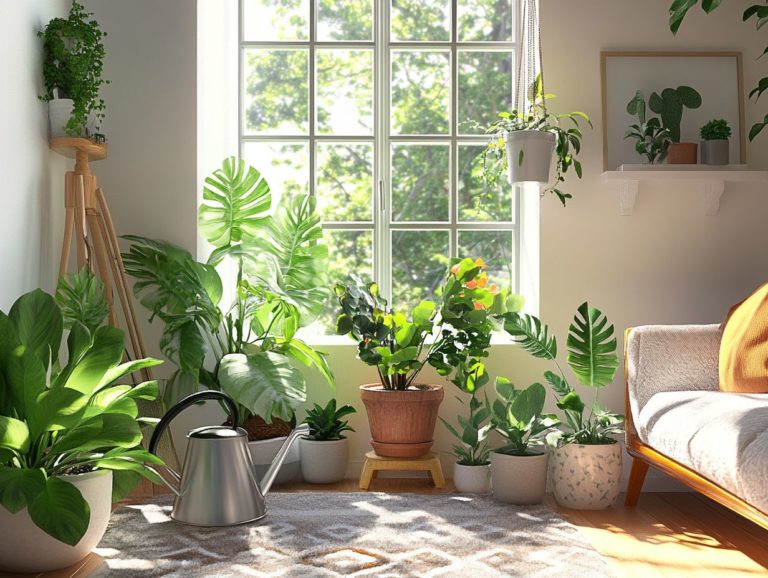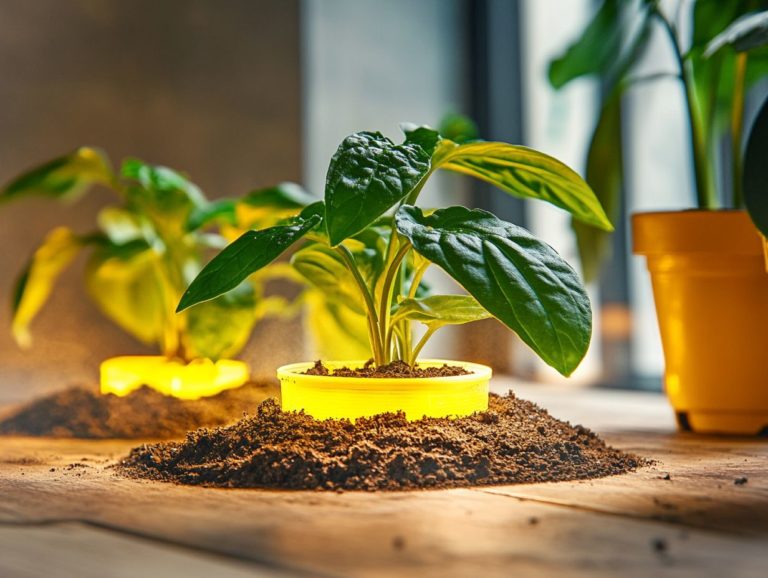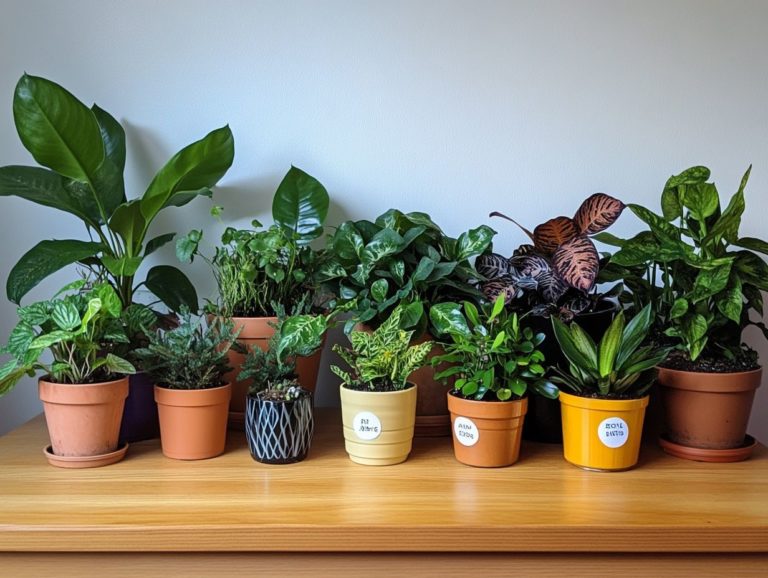Can Indoor Plants Purify the Air?
Indoor plants do more than simply beautify your space; they have remarkable air-purifying abilities that can significantly enhance your health and well-being, offering numerous psychological benefits.
Certain plants excel at filtering out harmful toxins and chemicals, a fact backed by scientific research. This exploration highlights various types of indoor plants known for their purifying properties and the key factors that influence their effectiveness.
You will also uncover practical tips for selecting and nurturing these green companions. Start cultivating a healthier indoor environment with your favorite plants today!
Contents
- Key Takeaways:
- The Air Purifying Abilities of Indoor Plants
- Types of Indoor Plants that Purify Air
- Factors that Affect Air Purification
- Benefits of Having Indoor Plants
- Tips for Choosing and Caring for Air Purifying Plants
- Frequently Asked Questions
- Can Indoor Plants Purify the Air?
- How do indoor plants purify the air?
- Which indoor plants are best for purifying the air?
- Can indoor plants remove specific toxins from the air, including volatile organic compounds (VOCs)?
- How many plants do I need to purify the air in my home?
- Do I need to do anything special to maintain air-purifying indoor plants?
Key Takeaways:

- Indoor plants have been scientifically proven to purify the air by removing harmful toxins and chemicals, improving air quality in your home or office.
- Some of the best indoor plants for air purification include spider plants, peace lilies, and snake plants, which are low maintenance and easy to care for.
- Factors such as light, water, and regular maintenance play a crucial role in the air-purifying abilities of indoor plants, so it’s important to choose the right plants and care for them properly.
The Air Purifying Abilities of Indoor Plants
Indoor plants, commonly known as houseplants, showcase remarkable air-purifying capabilities, significantly enhancing the air quality within your home by removing harmful pollutants and volatile organic compounds (VOCs).
A groundbreaking study by NASA revealed that these plants do more than just absorb carbon dioxide; they also filter out toxic chemicals and elevate the overall freshness of the air through the way plants use sunlight to grow and clean air.
This discovery has excited many homeowners and environmental enthusiasts in finding diverse species that contribute to cleaner indoor air and the benefits they offer to your living spaces.
Scientific Evidence and Studies
Numerous scientific studies, including the well-known NASA research on indoor air quality, present compelling evidence of the air-purifying capabilities of various houseplants. These findings underscore their critical role in environmental protection and in fostering a healthier indoor atmosphere.
Research has shown that certain houseplants, like the peace lily and snake plant, can dramatically decrease levels of nitrogen dioxide (a harmful gas from burning fuels) and volatile organic compounds (VOCs) while reducing air pollution in indoor spaces. A study published in the Journal of Environmental Horticulture revealed that common houseplants can eliminate up to 87% of indoor air pollutants within just 24 hours. For more information on how to enhance your indoor environment, check out this guide on using indoor plants to purify your air.
Another study found that specific species could reduce airborne toxins by as much as 50% within a week. These statistics not only highlight the effectiveness of incorporating greenery into your living spaces but also reflect the broader implications for your health and well-being standards.
Types of Indoor Plants that Purify Air
When exploring air-purifying options, you’ll find that certain indoor plants truly shine, each bringing distinct advantages to enhance your home’s air quality and foster a healthier atmosphere while contributing to environmental protection.
Consider the peace lily, spider plant, and golden pothos; these remarkable plants have been scientifically validated for their effectiveness in filtering out common indoor pollutants. If you’re wondering what indoor plants are best for offices, these options make excellent companions for your living space.
Best Plants for Air Purification

Imagine breathing cleaner air while surrounded by beautiful plants! The finest plants for air purification include the peace lily, renowned for its prowess in eliminating volatile organic compounds (VOCs), the spider plant, a favorite among newcomers for its resilience, and the golden pothos, which flourishes in diverse conditions while excelling at enhancing air circulation.
Each of these plants not only elevates the aesthetic appeal of your indoor spaces but also plays an essential role in improving air quality. Take the peace lily, for instance. It’s particularly adept at filtering out harmful substances like formaldehyde and benzene. This makes it an excellent choice for both homes and offices, especially when considering the best indoor plants for air quality.
The spider plant, with its adaptability, effectively absorbs carbon monoxide and xylene, contributing to a healthier living environment. Meanwhile, the golden pothos is famous for its trailing vines and skill at reducing a variety of toxins, including formaldehyde, even in less-than-ideal lighting conditions. To learn more about the benefits of having indoor plants, consider exploring how they can enhance your space.
When choosing these plants, consider your available space and light exposure. This will help you maximize their air-purifying potential while ensuring they thrive.
Factors that Affect Air Purification
The effectiveness of air purification by indoor plants is significantly shaped by key factors, including light exposure, water availability, and overall maintenance. Each of these elements plays a vital role in maximizing their air-filtering capabilities and enhancing your indoor environment s health.
Light, Water, and Maintenance
Know your plants! Light, water, and care are key to their success. Understanding the light requirements, water needs, and maintenance techniques is essential for maximizing the air-purifying potential of your indoor plants.
For example, the spider plant flourishes in bright, indirect light, while the peace lily prefers low-light conditions and benefits from consistent watering ideally once a week. It’s also important to monitor humidity levels, which refers to the amount of moisture in the air. Most air-purifying plants thrive with a bit of extra moisture, contributing to humidity reduction. Additionally, you might wonder how indoor plants can affect your mood and well-being.
Utilizing well-draining potting soil and regularly checking for pests can significantly enhance their longevity, making the air-cleaning benefits a continuous reality in your home.
Benefits of Having Indoor Plants
Having indoor plants goes far beyond merely enhancing air quality; they offer substantial psychological benefits. Their calming presence promotes mental health and elevates your overall well-being. Plus, you get the joy of nurturing a thriving indoor garden and integrating green walls into your space.
Improved Air Quality and Health Benefits

Improved air quality from indoor plants can bring you remarkable health benefits, especially when it comes to enhancing your respiratory health and alleviating asthma concerns. These plants work tirelessly to absorb toxins and pollutants, including chemical toxins, that often linger in indoor spaces.
Research reveals that specific varieties, like peace lilies and snake plants, excel at removing harmful substances such as formaldehyde and benzene from the air, contributing to air quality index improvements. For instance, peace lilies can reduce indoor pollution levels by up to 60% within just 24 hours. To explore more options, check out the top 10 air-purifying indoor plants.
Studies show that regularly being around plants indoors can significantly lower stress levels, which, in turn, may decrease the frequency of asthma attacks and allergies, further enhancing your respiratory health.
The sensory stimulation offered by greenery not only improves air quality but also creates a calming and rejuvenating atmosphere that is vital for your overall well-being.
Tips for Choosing and Caring for Air Purifying Plants
When you choose air-purifying plants for your home, consider factors such as sustainability, maintenance needs, and the unique characteristics of your indoor environment. Their role in cleaning air is significant.
This thoughtful consideration will enhance the effectiveness of air purification and contribute to your long-term success in nurturing these plants.
Have you considered how easy it can be to purify your indoor air? Start your journey to cleaner air today!
Factors to Consider and Maintenance Tips
When selecting air-purifying plants, consider factors like humidity, light, and air circulation. These elements are crucial for plant health and their air-cleaning abilities.
For example, humidity levels can affect a plant’s growth. Many air-purifying plants thrive in slightly moist environments, which you can achieve through regular misting or placing a humidifier nearby.
Understanding the light in each space bright, indirect, or low will help you pick suitable plants. This ensures optimal air filtering.
Good air circulation is essential. It prevents mold growth and keeps pests away. Rotate your plants regularly and place them where there s plenty of airflow to boost their health.
Frequently Asked Questions
Can Indoor Plants Purify the Air?
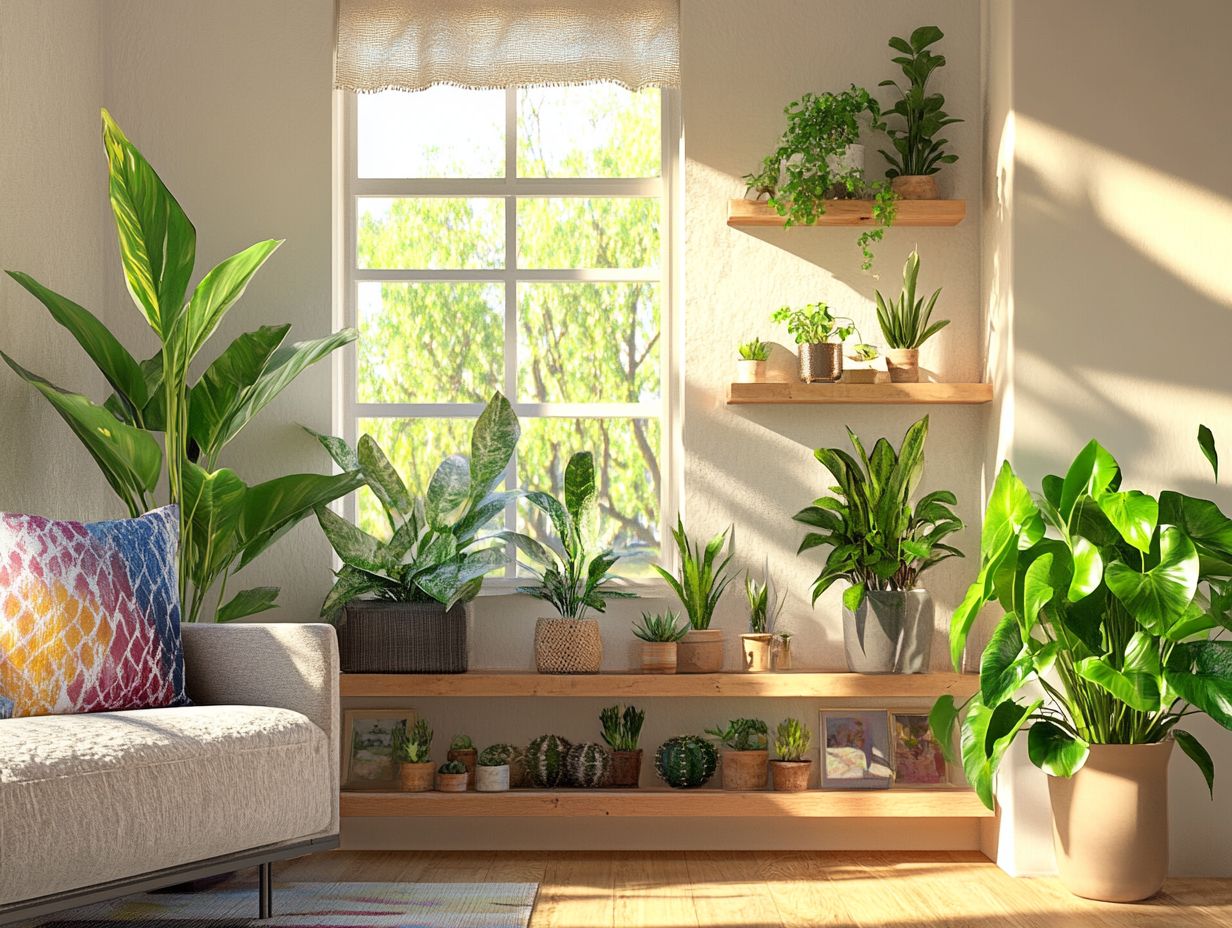
Absolutely! Some indoor plants are amazing at cleaning the air by removing toxins and pollutants through their leaves and roots.
How do indoor plants purify the air?
Indoor plants absorb harmful air pollutants through tiny openings on their leaves. The plants then break these down and convert them into nutrients.
Which indoor plants are best for purifying the air?
- Spider plants
- Peace lilies
- Pothos
- Snake plants
- Chinese evergreens
Can indoor plants remove specific toxins from the air, including volatile organic compounds (VOCs)?
Yes, different plants can target specific toxins. For instance, aloe vera helps remove formaldehyde, while English ivy can tackle benzene.
How many plants do I need to purify the air in my home?
The number of plants you need depends on your home’s size and the plants chosen. As a rule of thumb, aim for at least one plant per 100 square feet.
Do I need to do anything special to maintain air-purifying indoor plants?
Care for your indoor plants like any others. Ensure they get enough sunlight, water, and occasional fertilizer to keep their air-purifying powers strong.
Start your journey to a fresher home today by picking the right air-purifying plants!

